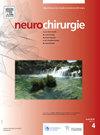Robotic hydrocephalus surgery: A systematic review of the effectiveness in neurosurgical interventions
IF 1.4
4区 医学
Q4 CLINICAL NEUROLOGY
引用次数: 0
Abstract
Background
Hydrocephalus is an abnormal buildup of cerebrospinal fluid (CSF) deep within the brain, resulting in clinical symptoms, including disorientation, vision disturbances, headaches, cognitive and developmental impairment. Traditional non-navigated surgical treatment, with ventriculoperitoneal (VP) shunt and endoscopic third ventriculostomy (ETV), may lead to complications such as shunt obstruction and inaccurate catheter placement. Robotics-assisted (RA) surgery has potential to improve precision of procedures. The objective of this systematic review is to assess the clinical effectiveness, complications, and benefits of RA surgical interventions in the case of hydrocephalus.
Methods
PRISMA-guided literature search was done in databases including PubMed, Web of Science, Cochrane Reviews, Scopus, and Embase. Inclusion criteria encompassed English language, original, peer-reviewed journal articles in robotic-assisted surgical interventions in hydrocephalus. Patient demographics, robotic systems used, and results were extracted.
Results
In total, 12 of the articles discussed robotic-assisted interventions for hydrocephalus. The robotic systems used included ROSA, NaoTrac, Remebot, and more. The findings established that the robotic systems are accurate. Almost all the studies showed successful outcomes with minimum robot-related complications like minor bleeding or conversion to manual surgery.
Conclusions
The evidence supporting the use of robot-assisted surgery for hydrocephalus management remains very limited in the literature. There is currently insufficient evidence to suggest that it offers any significant additional benefits in terms of patient outcomes, safety, or cost-effectiveness compared to conventional neurosurgical methods. Moreover, given the high maintenance costs of robotic workstations and prolonged surgery times, well-designed prospective controlled trials are needed to evaluate robotic effectiveness, compared to navigation-based techniques.
机器人脑积水手术:神经外科干预有效性的系统回顾
脑积水是脑深部脑脊液(CSF)的异常积聚,可导致临床症状,包括定向障碍、视力障碍、头痛、认知和发育障碍。传统的非导航手术治疗,如脑室-腹膜(VP)分流和内镜下第三脑室造口术(ETV),可能导致分流阻塞和导管放置不准确等并发症。机器人辅助手术(RA)具有提高手术精度的潜力。本系统综述的目的是评估脑积水病例中RA手术干预的临床效果、并发症和益处。方法在PubMed、Web of Science、Cochrane Reviews、Scopus、Embase等数据库中进行sprima引导下的文献检索。纳入标准包括机器人辅助脑积水手术干预的英文、原创、同行评议的期刊文章。提取患者人口统计数据、使用的机器人系统和结果。结果总共有12篇文章讨论了机器人辅助脑积水干预。使用的机器人系统包括ROSA、NaoTrac、Remebot等。研究结果表明,机器人系统是精确的。几乎所有的研究都显示出成功的结果,与机器人相关的并发症(如小出血或转向手工手术)最少。结论:文献中支持使用机器人辅助手术治疗脑积水的证据仍然非常有限。目前还没有足够的证据表明,与传统的神经外科方法相比,它在患者预后、安全性或成本效益方面提供了任何显著的额外好处。此外,考虑到机器人工作站的高维护成本和延长的手术时间,与基于导航的技术相比,需要精心设计的前瞻性对照试验来评估机器人的有效性。
本文章由计算机程序翻译,如有差异,请以英文原文为准。
求助全文
约1分钟内获得全文
求助全文
来源期刊

Neurochirurgie
医学-临床神经学
CiteScore
2.70
自引率
6.20%
发文量
100
审稿时长
29 days
期刊介绍:
Neurochirurgie publishes articles on treatment, teaching and research, neurosurgery training and the professional aspects of our discipline, and also the history and progress of neurosurgery. It focuses on pathologies of the head, spine and central and peripheral nervous systems and their vascularization. All aspects of the specialty are dealt with: trauma, tumor, degenerative disease, infection, vascular pathology, and radiosurgery, and pediatrics. Transversal studies are also welcome: neuroanatomy, neurophysiology, neurology, neuropediatrics, psychiatry, neuropsychology, physical medicine and neurologic rehabilitation, neuro-anesthesia, neurologic intensive care, neuroradiology, functional exploration, neuropathology, neuro-ophthalmology, otoneurology, maxillofacial surgery, neuro-endocrinology and spine surgery. Technical and methodological aspects are also taken onboard: diagnostic and therapeutic techniques, methods for assessing results, epidemiology, surgical, interventional and radiological techniques, simulations and pathophysiological hypotheses, and educational tools. The editorial board may refuse submissions that fail to meet the journal''s aims and scope; such studies will not be peer-reviewed, and the editor in chief will promptly inform the corresponding author, so as not to delay submission to a more suitable journal.
With a view to attracting an international audience of both readers and writers, Neurochirurgie especially welcomes articles in English, and gives priority to original studies. Other kinds of article - reviews, case reports, technical notes and meta-analyses - are equally published.
Every year, a special edition is dedicated to the topic selected by the French Society of Neurosurgery for its annual report.
 求助内容:
求助内容: 应助结果提醒方式:
应助结果提醒方式:


